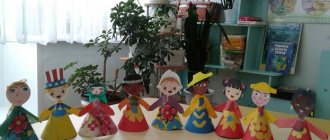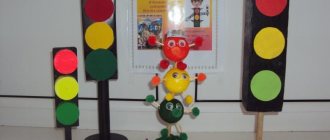Traffic light
The purpose of the didactic game “Traffic Light” is to develop an understanding of what a traffic light is, why it is needed on the road, and what the light signals mean.
The lesson is intended for the younger group of kindergarten. To carry it out, prepare a schematic representation of a traffic light with unpainted signal lights, and separately – cardboard circles of 3 corresponding colors.
Give the children circles and tell them what function the device performs on the road. Name the color one by one, and the children must guess and explain what the indicated color could mean: red - wait, yellow - wait, green - you can go. At the end of the lesson, students, with the help of the teacher, distribute circles according to signal lights.
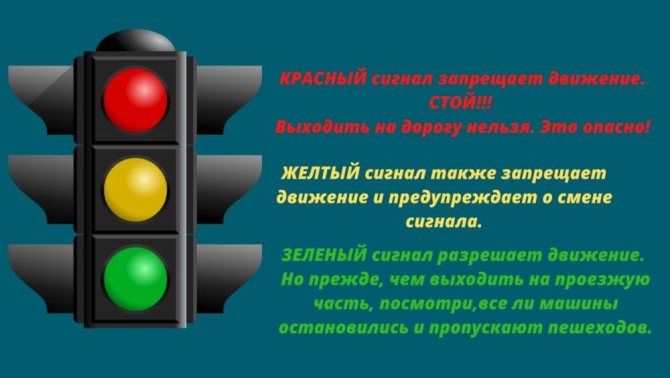
Didactic game “Our assistant traffic light”
Didactic game: “Our assistant is a traffic light”
The game is intended for children of primary preschool age (from 2 to 4 years old). At the initial stage, children play games with an adult, then independently.
Target:
To form in children ideas about basic traffic rules.
Educational objectives:
Introduce children to the traffic light and form an idea of its purpose and signals: red light - STOP (prohibits movement), green light - GO (allows movement), yellow light - WAIT.
Form an idea of spatial relationships (above, below, in the middle).
To consolidate children's ideas about color - determine the circle of the desired color (visual correlation: red, yellow, green).
Activate and enrich children's vocabulary using words: signal, road, pedestrian, traffic light, pedestrian crossing; above, below, in the middle or between.
Developmental tasks:
Develop fine motor skills by performing actions with objects.
To develop children's attention and speech through the ability to listen, understand content and repeat individual words and verbal text.
Develop the ability to correctly place circles on a traffic light layout.
Educational tasks:
To develop children's pedestrian behavior skills.
Evoke an emotional response from the game process.
Rules and options for the game.
Game "Getting to Know the Traffic Lights"
The game is attended by two to four children and an adult leader.
The adult invites the children to get acquainted with the traffic light.
A traffic light is a friend to everyone, it is the most important thing on the road.
A traffic light indicates when you can cross the road and when you can stay put. All pedestrians must obey him.
Let's look at a traffic light - it has three signals: red at the top, green at the bottom, and yellow between them or in the middle.
Then the adult offers to repeat everything again, together, pronouncing the main phrases.
Sedentary game “Pedestrian crossing”
The game is attended by two to four children and an adult leader.
The presenter invites the children to be pedestrians and try to cross the road at a pedestrian crossing.
-And the traffic light will help us with this, listen carefully and do:
“Before you cross the road, look at me. If I turn on the red light, it means it’s dangerous to move (stop - the children are standing still), if the light is green, walk on - the path is open (walk - the children imitate walking), but the yellow light is on - there is no more crossing, don’t rush, wait, very soon the traffic light will light up a new eye (wait - the children stand and pronounce the words together with the leader, clapping their hands).”
The teacher accompanies the verbal text by showing the necessary signals on a traffic light model.
The game is repeated several times.
Game “Help the traffic light find its lights”
The game is attended by two to four children and an adult leader.
The traffic light invites children to play with it:
“Something happened to me and I lost my lights, please help me!” (children are asked to fix the traffic light).
Children take turns “helping” the traffic light.
During the game, the adult asks the children questions:
-What color is this light?
— Where is it located: at the top, bottom or in the middle?
- What does this light mean?
If children are having difficulties, the adult enlists another child to help.
As a result, the traffic light thanks all the children for their help and offers to always be friends and never forget about him.
Game "The traffic light has lost its light"
3 children can play. There are traffic lights in front of the guys. The traffic light has two colors, and instead of the third there is a white circle. And nearby there are chips of red, yellow and green colors. The child’s task is to pick up the right chip and put it on the traffic light where it should be. The one who completed the task faster than the others wins.
The game can be somewhat complicated by turning over the chips. Children take turns taking a chip, opening it and saying whether it fits their traffic light or not. If it fits, they keep it and put it on their traffic light.
Didactic game: “Our assistant traffic light” PPTX / 808.42 Kb
Find the warning lights
This game also requires a schematic representation of a traffic light with separate colored circles. But the task is more complicated, intended for the middle group: preschoolers select the signal lights themselves, focusing on the teacher’s leading questions.
Tell the students that there is a problem on the road: cars cannot move because the traffic lights are out of order. Ask the children to help the drivers, return the signals to their place.
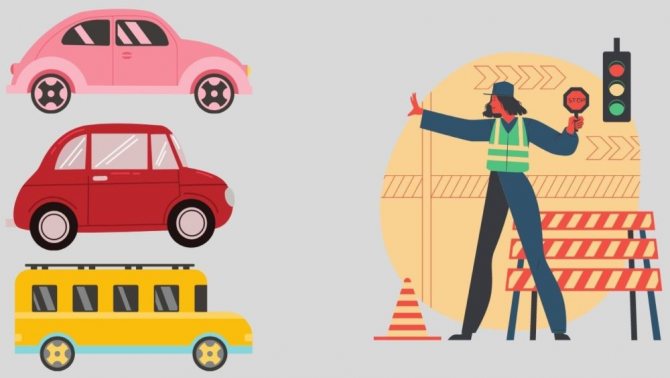
During the game, ask the players one by one:
- what color is the signal;
- where it is located - at the top, in the center, at the bottom;
- which means.
If the child finds it difficult to answer, ask the same question to the next player.
Pick up the signal light
The game is competitive, 3 preschoolers play. Prepare for the lesson images of traffic lights, in which two lights are colored, and instead of the third there is an empty circle. You also need cardboard circles in 3 colors.
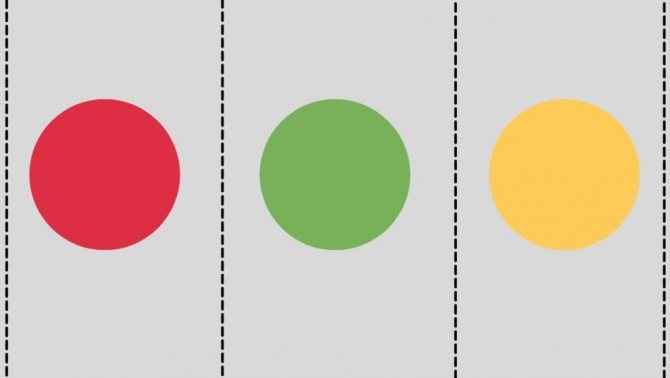
Place the images in front of the players. Ask them to remember what color the unpainted signal circle should be. Children remember, choose a cut out circle, and apply it to an unpainted traffic light. The player who makes the most correct moves and completes the task faster than his comrades wins.
The game for the preparatory group can be complicated by turning the cut out circles upside down. Players take turns taking circles, turning them over, calling a color, and seeing if the color suits their traffic light. If yes, they put it on the corresponding signal light; if not, they put it aside and pass the move to a comrade.
Methodological development on traffic rules in junior group 1: “Familiarization with traffic lights”
Balloons
Organization of children: Number of children: whole group. Children's position: sitting on chairs placed in a semicircle in front of the teacher. PROGRESS OF THE LESSON Actions of the teacher Actions of the children (approximately) I Introductory part: There is a knock on the door. The teacher comes in, pulling the car by the rope. There are cubes in the back of the car.[4]
- Hello children. What a big car has arrived. She brought the goods. Look at the cubes, what colors are in the car? - That's right, guys, well done. - Where on the street can we see these colors? - Yes, guys, well done.
— Red, yellow and green.
- Traffic light.
II Main part: The teacher shows a drawing of a traffic light and a “Traffic Light” toy.
— Guys, let's look at the traffic light. Red means there is no road, yellow means get ready, and green means the path is open for pedestrians. - Let's play this game: Nastya, Seryozha and Polina will be our pedestrians. The red light comes on - we stop, the yellow light comes on - we are getting ready, the green light comes on - we go. - And now the guys will play another game: Seryozha, Maryam, Artem will be machines. — We will fix the colors of the traffic light. — What color are cars allowed to drive in? The teacher shows a green cube - the cars are moving, shows a yellow one - they are getting ready, a red cube - everyone stops. - Right. And we stand on red. The teacher hands out the cubes to the children, and they name the colors they got.[5]
Let's play.
- Yes.
- Yes.
- To green.
III Final part - Guys, let's see what the car consists of.
-Children, what is that by the car? (The teacher points to the wheels). - Children, and the car is rolling on wheels (the children with the teacher who is driving the car go and stop by the carpet, they look at the car). - Children, what do you call this on the car? (Points to the cabin). — What color is the cabin? - Right. Who will show me the body? (Children show). — Children, what color is the body of the car? (the teacher encourages you to repeat with him and individually). Right.
- Wheels.
— Cabin
— Green
- Yellow
VI Lesson summary: The teacher takes out balloons. [6]
— Guys, what colors are our balls? - Right. The teacher gives the children balls and they play with them.
-Red, yellow, green.
In introducing children to the rules of the road, it is currently necessary to use innovative methods, which include algorithmic games. In these games, children learn to think, reason, overcome difficulties, and use their knowledge in practice. The purpose of algorithmic games is not only to reinforce the rules of the road, but also to teach orientation in space, to develop monologue speech, and to develop logical thinking. Examples of algorithms, “Crossing a street with a traffic light”, “The road home”, the purpose of which is to teach children the rules of crossing the street without violating traffic rules. When working with children to familiarize themselves with traffic rules, it is effective to use printed board games.
Traffic light
To conduct the game “Traffic Light” in the older group, make preparations: divide the landscape sheets in half, on one half depict a traffic light with incorrectly located lights, on the other - a device with empty circles instead of signals. Separately cut out circles of 3 colors.
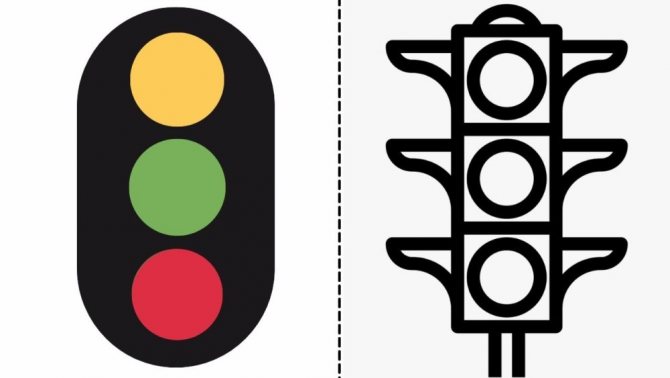
The players' task is to identify the incorrect placement of lights. On the neighboring device you need to display the light signals correctly, arranging the circles accordingly.
Build a traffic light
The didactic game “Assemble a traffic light” reinforces the idea of the purpose of a road device, develops attentiveness and thinking abilities. For the lesson, prepare images of traffic lights - one per player, and circles made of cardboard in 3 colors. Randomly cut each circle into 4 parts.
Tell the students that the traffic lights are broken and need to be fixed. Children fold circles according to colors and order of arrangement. At the end of the work, the students tell what each traffic light means.
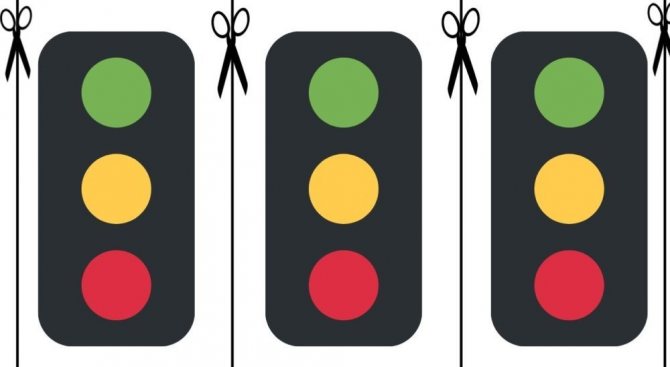
Taxi drivers
This is an active game that reinforces ideas about the rules of the road, improves motor activity, and develops the skill of collective action and interaction with friends. For the lesson you need hoops and cardboard circles in 3 colors. Roads and pedestrian crossings must be marked on the playground.
The children are divided into pairs: one is a taxi driver, the other is a passenger. Each pair stands in a hoop, one child holds it with his right hand, the second with his left: this will be a car. Other children become pedestrians and traffic lights, while others receive 3 signal circles.
The game begins: taxi drivers and passengers run along the paths, pedestrians walk along the crossings, the rest show signal lights. Players' actions must be consistent with traffic signals. If necessary, the teacher gives hints and corrects the students’ movements.
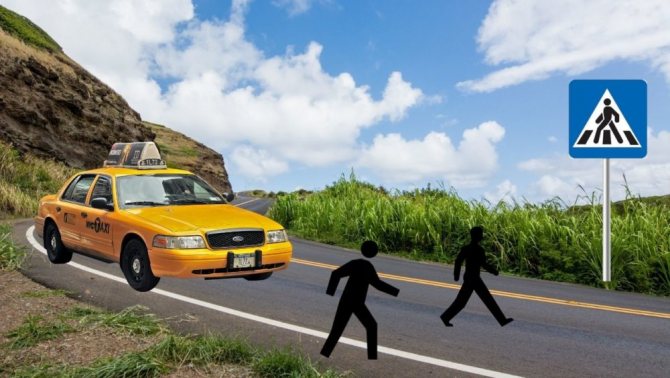
Description: This material will help the teacher organize work with children 2-3 years old and their parents to develop basic knowledge of road safety rules. Didactic game “Which light came on” Objectives: consolidate knowledge of traffic light colors. Equipment : “Live picture” - a street, a picture of a traffic light with round holes, circles in red, yellow and green. Contents of the game. The teacher alternately inserts circles of different colors into the traffic light holes in the “Live Picture” and invites the children to name these colors and explain what they mean for pedestrians. Didactic game “What does the traffic light say?” Objectives: to form children’s elementary ideas about the meaning of the colors of the traffic light and the rules of the road. Equipment: “Live picture” - street, pictures: traffic lights, cars for various purposes; road markings, figures of people. Contents of the game. The teacher prepares a model of the road with pedestrian crossing markings, creates various traffic situations using human figures, and invites the children to show the correct behavior of pedestrians and drivers on the road. Didactic game “What’s missing” Objectives: consolidate knowledge about car parts. Equipment: pictures of cars, car parts. Contents of the game. The teacher shows the car, clarifies what is missing, then offers to find a picture with the missing part. Didactic game “Our Street” Objectives: to form children’s elementary ideas about the concepts: street, road, sidewalk, trees, houses; basic understanding of the rules of behavior on the road. Equipment: “Live picture” - a street, a picture of a traffic light with holes, circles of red, yellow and green colors, figures of children, pictures of cars, road signs. Contents of the game. The teacher shows the children a picture and tells them that when crossing the road, they should not rush, they must be careful, they must not play near the road, cross the road at a pedestrian crossing, distinguish between traffic lights (green - you can go, red - no movement), road signs . Didactic game “What do we drive?” Objectives: to teach children to recognize and show vehicles by ear. Equipment: pictures of vehicles. Contents of the game. The teacher reads a poem to the children, then asks what it says and asks the child to find a picture of this vehicle. The steam locomotive The locomotive hummed and the carriages were carried away. Chu-choo, choo-choo! I'll take you far! (T. Volgina) Truck No, in vain we decided to Ride the cat in the car: The cat is not used to riding - He overturned the truck. (A. Barto) Airplane We’ll build the airplane ourselves, Let’s fly over the forests. Let's fly over the forests, and then return to mom. (A. Barto) Helicopter Helicopter, helicopter! Take me on a flight! And in flight it’s empty, cabbage has grown! (teaser) Ship Sailor cap, rope in hand. I’m taking a boat along a fast river, and the frogs are jumping on my heels, and they ask me: “Give me a ride, captain!” (A. Barto) Didactic game “What do we drive?” Objectives: to teach children to recognize familiar vehicles, to designate them in words. Equipment: “Live picture” - street, pictures of vehicles. Contents of the game. The teacher one by one inserts pictures of vehicles into the holes in the “Live Picture” and asks what is drawn on it. Children answer on their own or with the help of a teacher. Then the teacher offers to look at the picture and notes what color the machine is, what it is needed for, and together with the children names its parts, etc. Didactic game “Let me tell you something” Tasks: Fix the name of the transport, activate the dictionary. Equipment: toys bus, truck, car, plane, boat. Contents of the game. Toys are on the table or carpet. The child is at a distance of 1-2 meters from the table. The teacher asks the child: “Bring a bus (plane, truck, etc.).” If the child finds it difficult, the teacher clarifies: “It is red, standing near the plane,” or simply points to the desired toy. Then he asks questions, specifying what the child brought, what color the bus is, its size; look at its parts. Didactic game “Wonderful Bag” Objectives: Clarify and activate the vocabulary on the topic “Transport”. Equipment: Toys: bus, truck, car, airplane, boat, bag. Contents of the game. The teacher takes the cars out of the bag one by one. Together with the child, he examines and discusses their appearance (truck, bus, etc.), color, material, purpose. Specifies the name of the parts, their color and shape.

